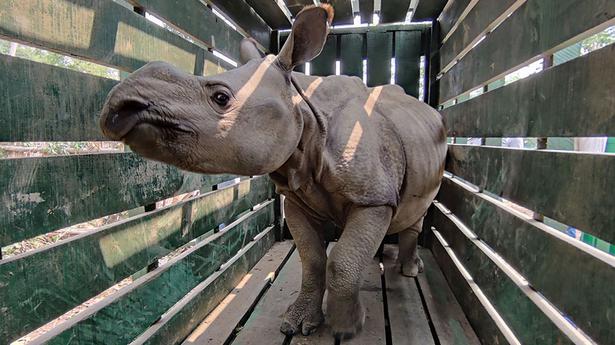Manas National Park rhinos have higher life expectancy but need translocation support, reveals latest census
Manas National Park rhinos have higher life expectancy but need translocation support, reveals latest census
The one-horned rhinos of western Assam’s Manas National Park, bordering Bhutan, have an age structure pyramid, indicating higher life expectancy and significant growth in the population.
On the flip side, the 500-sq.-km park does not have “a wider representation of calves and sub-adults” to sustain the population structure unless it is supplemented through conservation translocations, the 14 th Assam rhino estimation conducted in April has revealed.
Manas, a UNESCO World Heritage Site and a tiger reserve, had about 100 resident rhinos prior to 1990, but a prolonged ethno-political conflict thereafter took a heavy toll with extremist groups known to have traded the horns of the herbivores for weapons.
A rhino reintroduction programme under the Indian Rhino Vision 2020 was started in 2006. This entailed the translocation of rhinos from Kaziranga National Park and Pobitora Wildlife Sanctuary besides orphans hand-reared at the Centre for Wildlife Rehabilitation and Conservation at Kaziranga.
The current rhino population in the park was estimated at 40 after the census on April 1 and 2.
A detailed census report by Vaibhav C. Mathur, the field director of Manas, said the park’s rhinos have a male-female sex ratio of 1:1, arrived at without considering 10 calves and five sub-adults.
“The number of calves born in the wild reflects the availability of welfare factors to foster rhinos in Manas National Park,” said the report, obtained through RTI by environment activist Rohit Choudhury.
“Keeping in view the 1:1 adult as well as the 1:1 sub-adult male to female ratio, we assumed the same to hold good for calves in respect of constructing a population pyramid for rhinos at Manas. This reveals the following structure: The graph is clearly indicative of a low birth rate, but is also suggestive of a lower death rate, which means that there is higher life expectancy,” the report said.
But such a population may suffer losses if not supplemented through translocations, the report warned. “A suitable strategy to bring in more rhinos from other rhino-bearing areas is required so as to have a wider representation of calves and sub-adults over time,” it said.
Counting limitations
The census report said the “total count” or direct count method adopted for the population estimation in Manas has a few limitations.
A total count is generally used when a single species is targeted to be counted in a well-defined, specific area. This method assumes the detection probability to be one, which means that each and every animal has a 100% chance of being seen during the counting.
The total area is divided into smaller units or blocks separated by natural barriers such as rivers or streams and forest paths, which is supposed to take into account population closure. This means no animal can move in or out during the counting process, the report said.
The limitations of this method, the report said, include undercounting, as the assumption of a detection probability of 1 is unrealistic, especially if the population closure cannot be established satisfactorily within a small area of 10-20 sq. km.
Total count requires high visibility to observe the animals from far off, which is not possible in case of “shy, cryptic animals”. The level of precision cannot be measured in total counts too, the report said.
The rhino census in the Manas park was carried out in all three ranges – Bhuyanpara, Bansbari and Panbari – comprising 71 estimation blocks. Each anti-poaching camp and its adjoining area was considered a sample block with some anti-poaching camps in close proximity merged to form a single block.
Speed limit
Meanwhile, the Kaziranga National Park authorities have restricted the speed of vehicles on the highway adjoining the park to 40 km per hour. This is an annual step taken to prevent vehicles from hitting animals that move out of the park during high floods.
Officials said six sensor-based cameras have been installed at nine designated animal corridors of the park to measure the speed of vehicles and impose fines on those who violate the order.






